News & Articles
Insurance company tries to screw Minneapolis homeowner
September 16th, 2012
by Aaron Fruit

News flash. Your insurance company is not always looking out for your better interest. In fact, in the past 30 years they have developed sophisticated internal systems for limiting, delaying or denying claims altogether. Here is one such story.
I just inspected a cedar roof on Prairie Lakes Drive in Eden Prairie and was shocked to find that this poor homeowner, let’s call her Jane, had been duped. Twice. First by an unscrupulous roofing contractor who’s name I am dying to print here (but I won’t for fear of getting my tires slashed). The second and deeper shock came from realizing Jane’s insurance company pulled a major fast one too. I won’t mention the name of said company but I’m happy to tell you in person if you’re interested. Their marketing gestures usually are centered around how well they will take care of you when a tragedy occurs. What a load of crap.
The short story is that a door to door roofer convinced Jane to let him inspect her roof for storm damage. He went up on her roof and created fake wind damage in over a dozen areas. The whole thing took less than twenty minutes. Pretty impressive work when you think about it. Also totally illegal. Jane’s insurance company caught on to the scam after they inspected the roof, issuing a fancy 20 page report that acknowledged the roof was damaged, but not by wind. Jane’s claim was denied. The only problem is that Jane’s insurance company neglected to tell her she-like 99% of all insured homeowners-was covered for vandalism, and that’s exactly what had occurred on her roof. Her insurance company acted in bad faith and quietly let the whole thing pass hoping Jane wasn’t sophisticated enough to fully understand the esoteric language in her policy that detailed her coverages.

Can you find the vandalism on this roof?
Here is the timeline of events in greater detail:
August 2011:
A representative from a roofing outfit doing some work down the street knocks on Jane’s door and suggests she may have wind damage to her cedar roof. Being a trusting soul, Jane gives him permission to get up there and conduct an inspection. The roofer proceeds to hop around the roof, manually pulling up small areas of cedar roofing to simulate wind damage to the best of his ability. He damaged between 12 and 14 areas in total inside of 20 minutes. And yes, this sort of thing can be done quietly if you’re an experienced D-bag like this guy. Sir D-bag then gets off Jane’s roof, knocks on the door and tells her she should call her insurance company because her roof needs replacing due to storm damage.
September 2011:
The sketchy roofer meets with a claims adjuster from Jane’s insurance company on the roof to review the damage. He points to all of the spots he damaged and suggests the entire roof needs to be replaced due to severe wind damage. The adjuster takes copious notes and photographs in addition to conducting four test squares (more on that later). At the end of the meeting the adjuster tells Jane he will be sending her a report to summarize his findings within a week or so, noting before he left that there is clearly a number of damaged areas on her roof. He purposely leaves out the part about what caused the damage because he didn’t want to end up in a fist fight with the roofer, who was still hovering around.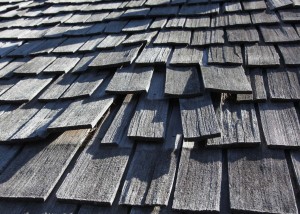
One week later Jane receives a written statement from the adjuster indicating the need for an additional roof inspection from Haag Engineering, a firm specializing in many types of structural, mechanical and geological engineering diagnostics and investigations. (Side note: Haag Engineering earns the vast majority of it’s revenue from referrals from insurance companies and has been accused of bias in a number of law suits around the country.) I am a Haag Certified Inspector and suspect my certification will be yanked when they learn that I’ve bad-mouthed them here. Oh well. I want the truth to be out there.
October 2011:
Haag Engineering inspects Janes’s roof and determines it is damaged, not by a storm or some other natural event but through “mechanical lifting”. This is insurance industry code for someone got up there and damaged the roof on purpose. Engineering reports and insurance policies are intentionally opaque and confusing for the simple reason that most people are too busy to dig in and figure out exactly what all of the jargon means. Hence is the case with Jane’s cedar roof in Eden Prairie. Her cedar roof was vandalized but the boys from Haag avoided using that word because it would raise red flags and cost their employers-the insurance company-a lot of money.
Shortly after receiving Haag’s report through her insurance company Jane was notified by her claims adjuster that her roof damage was not covered. Not being a cedar roof expert or homeowners insurance underwriter, Jane and her husband shrugged their shoulders and assumed they needed to start saving money to pay for the roof replacement themselves (about $39,000). No one from Haag or from Jane’s insurance company mentioned that her roof had been intentionally damaged, at least not in language the average person comprehends and so the claim quietly slipped away, along with any chance for financial recourse.
August 2012:
Now a year later, Jane and her husband had saved up enough money to get their cedar roof replaced. They felt good about using the roofer that was so helpful in working with their insurance company last fall (the very scammer that damaged their roof on purpose). Why wouldn’t they? Yet just to be a smart consumer Jane asked around her social circle for the name of another roofer to get a second bid. That’s when she called us. It turns out we have worked for four other neighbors.
I inspected the roof and found that other than the aforementioned isolated damaged spots it was in decent condition. After being repaired I estimated that it had another six years minimum of additional life. As I walked around from area to area I quickly realized I was looking at a clear case of vandalism. I took many high resolution photos of the damaged areas. After explaining to Jane what I had found she was appropriately shocked. Worse, when I told her the roof damage should be covered by her insurance she was shocked even more because her claim had been denied.
I advised her to immediately call her insurance provider and pursue the coverage she deserved. I offered up the services of our in-house insurance badass, Pete, who has been in the business for almost as long as I’ve been alive. Pete frequently spanks around insurance claims reps and adjusters who try to play games with our clients. It’s somewhat amusing to watch. I am eager to see what happens in this case because it is such an ugly situation and she was so cool to deal with.
I will follow up in another blog with the outcome. I also plan on creating a Kuhl Case Study soon that will have photos of the damage done by the original roofer.
Posted in Uncategorized
Hail Damage On Cedar Roofs
July 2nd, 2012
by Aaron Fruit
 As I love to say, after a hail storm ends it often starts raining losers. And by losers I mean to say contractors who rely on the general anxiety, hysteria and misinformation that dominates the hail battered suburban landscape immediately after the storm passes through. There are the typical roving bands of storm chasers that travel the country, from one storm to the next. Fortunately most of those guys can be avoided by asking for a few local vender references and how long they have been in their local office. The tougher ones to figure out are the so-called hail experts that make grand promises about success with your insurance company regardless of the presence of legitimate hail damage.
As I love to say, after a hail storm ends it often starts raining losers. And by losers I mean to say contractors who rely on the general anxiety, hysteria and misinformation that dominates the hail battered suburban landscape immediately after the storm passes through. There are the typical roving bands of storm chasers that travel the country, from one storm to the next. Fortunately most of those guys can be avoided by asking for a few local vender references and how long they have been in their local office. The tougher ones to figure out are the so-called hail experts that make grand promises about success with your insurance company regardless of the presence of legitimate hail damage.
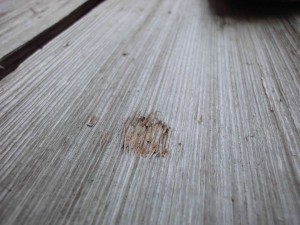 When it comes to hail damage on cedar roofs in Minneapolis, or anywhere for that matter, the signs are pretty clear to the trained observer. Cracks and dents are the bread and butter of my hail damage inspections. How many hail-related cracks per test square are there? Side point: a “Test Square” is a 10′ x 10′ representative area of roof slope that inspectors used to determine how much hail damage exists. All else held equal, we can count the number of hail hits per test square and extrapolate that number across all squares on a common section or slope.
When it comes to hail damage on cedar roofs in Minneapolis, or anywhere for that matter, the signs are pretty clear to the trained observer. Cracks and dents are the bread and butter of my hail damage inspections. How many hail-related cracks per test square are there? Side point: a “Test Square” is a 10′ x 10′ representative area of roof slope that inspectors used to determine how much hail damage exists. All else held equal, we can count the number of hail hits per test square and extrapolate that number across all squares on a common section or slope.
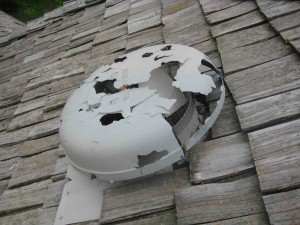
Anyway, back to the losers. Aside for the parasitic national storm chasing gangs that travel from spot to spot there are local companies that employ equally questionable tactics in securing hail damage work. I always suggest that people stick with the companies that fit three simple criteria when selecting a contractor to fix their hail damaged anything: 1) Choose a company that has been around for a while, 2) Work with a company that has specific skills in insurance work, and 3) Use someone with an excellent reputation and a long list of happy clients you can call.
Here are a couple of Kuhl Case Studies that relate to hail damage in Minneapolis:
Storm chaser leaves Edina Homeowner Screwed – Kuhl Case Study #29
Cedar roofing with hail damage – Kuhl Case Study #19
What does hail damage look like up close – Kuhl Case Study #20
Posted in Uncategorized
Roof Replacement Costs in Minneapolis
March 2nd, 2012
by Aaron Fruit
 I get asked all the time how much roofs cost to replace here in the Twin Cities. That’s sort of like asking how much a car costs. It depends on many variables. But for the sake of trying to be as helpful as I can in answering that question (the one about roofing costs) here are some very general guidelines you can follow. Technical note: guys like me throw around the term ‘Square” when referring to roof measurement. Roofing labor and material prices in Minneapolis are determined according to squares, which is to say units that are 10′ x 10’ in dimension. Most roofs in the Twin Cities are in the 25 to 50 square range.
I get asked all the time how much roofs cost to replace here in the Twin Cities. That’s sort of like asking how much a car costs. It depends on many variables. But for the sake of trying to be as helpful as I can in answering that question (the one about roofing costs) here are some very general guidelines you can follow. Technical note: guys like me throw around the term ‘Square” when referring to roof measurement. Roofing labor and material prices in Minneapolis are determined according to squares, which is to say units that are 10′ x 10’ in dimension. Most roofs in the Twin Cities are in the 25 to 50 square range.
Material Costs for Minneapolis Roofing:
No other single factor determines the price of a roofing project than the material chosen (except for roof size, of course). For example, asphalt shingles of standard quality cost around $95 to $140 per square right now in Minneapolis. We receive almost monthly notifications from our asphalt shingle vendors that price increases are on the way so keep in mind the date of this post. Asphalt shingle roofing in Minneapolis as little as a couple years ago used to cost half that of cedar shake and shingle roofing. Not so much anymore as the price of oil has increased and taken all petroleum based products along with it. We installed a designer series asphalt shingle roof on Lake Harriet not too long ago that cost more than a cedar roof, as a matter of fact. Cedar roofing material prices currently range from $170 to $270 per square. That’s a huge range, which is appropriate once you start to understand the wide spectrum of possibilities when buying cedar shakes and shingles in Minneapolis. Asphalt shingles and cedar roofing represent 98% of the roofing market in Minneapolis so I will limit my comments to those two for now. Ancillary roofing materials such as fasteners, felt paper, ice and water membrane and flashings also add up when trying to determined how much it costs a roof on in Minneapolis. Those costs are described more on our website if you are interested.
Pitch & Height:
The higher the roof and the steeper the roof the more expensive the work will be. All you have to do is imagine yourself up there and the importance of height and roof pitch in what you would need to charge for your time crystalizes pretty quickly.
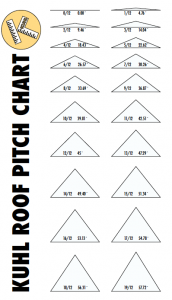
Labor Costs for Minneapolis Roofing:
Labor costs for roofing work in Minneapolis and surrounding communities will range from $190 to $325 per square depending on the above mentioned variables. Some contractors include the costs of permits and dumpsters in their labor charges while others do not. We prefer to separate all of the costs line-by-line so you can see where you are spending you money.
Average Roof Replacement Costs in Minneapolis:
Here are some quick and dirty numbers for your consideration:
$425 to $550 Cost to replace an asphalt shingle roof in Minneapolis
$625 to $750 Cost to replace a cedar roof in Minneapolis
Here are some recent roof replacement costs for projects completed around the Twin Cities, including roof size and roof pitch:
- $32,230 Cedar roof replacement cost in Edina using heavy hand-split cedar shake roofing on a 46 square 10/12 pitch gabled cedar roof
- $26,409 Asphalt roof replacement cost in Shorewood using Timberline HD Ultra asphalt roofing on a 60 square 11/12 pitch hip roof
- $27,320 Cedar roof replacement price in Wayzata using hand-split medium, Blue Lable Certified cedar shake roofing on a 42 square 8/12 pitch cedar roof
- $37,511 Cedar roof replaced in Orono using 16″ cedar shingles with 5″ exposures on a 53 square hip roof (roof pitches ranging from 4/12 to 12/12)
- $11,600 Asphalt roofing project cost in St. Louis Park using Timberline HD asphalt shingles on a 24 square Cape Cod home, 10/12 pitched gable roof (price included chimney work)
- $42,477 Cedar shake roof replacement in Minnetonka using treated medium cedar shakes on a 58 square 9/12 pitch hip roof
- $8,280 Asphalt roof replaced in Hopkins using GAF asphalt shingles on a 15 square gable roof with a 10/12 pitch and three dormers
- $29,800 Cedar roofing replacement cost in Orono using heavy hand-split shakes on a 40 square gambrel roof with 18/12 and 4/12 roof pitches
Posted in Uncategorized
Blending Old Cedar with New Cedar
November 4th, 2011
by Aaron Fruit

There are 10 repairs in this photo. Can you spot them? This is a 11 year old wood roof one year after Kuhl replaced damaged cedar shakes. Orono wood roof one year after insurance repair work.
Minneapolis Wood Roof Owners FAQ’s
1. If our wood roof is washed, how well with the new shake repairs blend in?
2. If we choose not to clean our cedar roof, how long with the new cedar shake repairs be obvious?
3. What can we do to get the new cedar roof repairs to match our old cedar roof?
I get asked these and related questions all the time.
Here are a few insights I’ve gathered over the years that might help. First, cedar fades as the result of basic oxidation. Ultra-violet rays break down the lignin (the glue that holds wood cells together) and as that occurs the surface begins to grey. Variables such as the orientation of the roof pitch (north, south, east, west), the roof pitch, tree coverage and character of the wood itself will factor in to how quickly the new cedar shake and shingle repairs will fade. There are chemical agents that hasten the fading process slightly but there is nothing that will instantly blend old cedar roofing with new. Not in a permanent sense anyway. Another approach to blending new cedar roofing with old is the use of tinting or staining. We can tint and stain new wood roofing repairs to blend into the surrounding roof in such a way that those repairs will be hard to detect from the ground. The problem is that as the new cedar begins to fade and change colors through natural weathering, what was once a good match becomes an increasingly obvious eyesore. When it come to blending new cedar roof repairs with an existing roof our advice is simple. Either wash the roof and have more immediate material color consistency or exercise patience and wait for the new to fade in to the old. Of course, in situations where the existing roof is quite dark, as in the case where black mold, moss or lichen as moved in, the new shake repairs are not likely to ever blend in well.
Another interesting and very important thing to note about the main photo at the top of this post is the natural variation in the original roofing. You can see 40-50 pieces that are significantly lighter grey than surrounding pieces. The most obvious patch is a little over half way up the pictured roof slope slightly left of center. Those shakes were installed 11 years ago but for some reason have not faded at the same pace as surrounding material. This is most likely due to differences in the chemical composition of those shakes. They were either taken out of a different part of the tree or from a different tree altogether (more likely). Cedar roofing is a natural material and will have a wide range of coloration as the result. If p
erfect color consistency is your goal it is best to avoid cedar shakes and shingles.
Here is 12 year old, medium hand-split cedar shake roof in the same neighborhood as the subject roof. The new shakes are quite obvious from the ground. They will blend in quite well within a year.
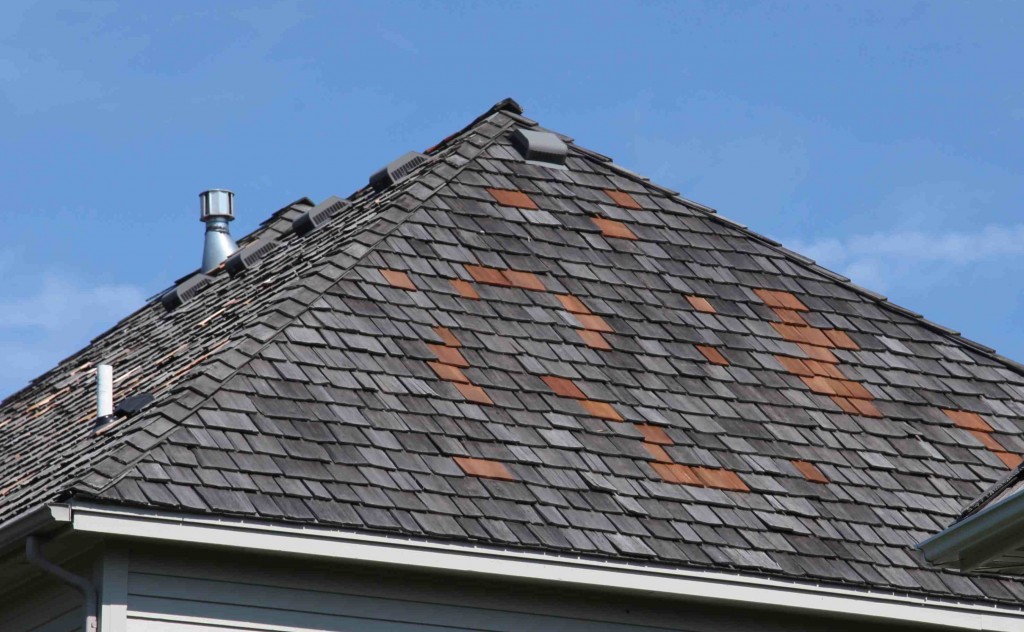
12 year old cedar shake roof in the same neighborhood. These repairs are less than one week old.
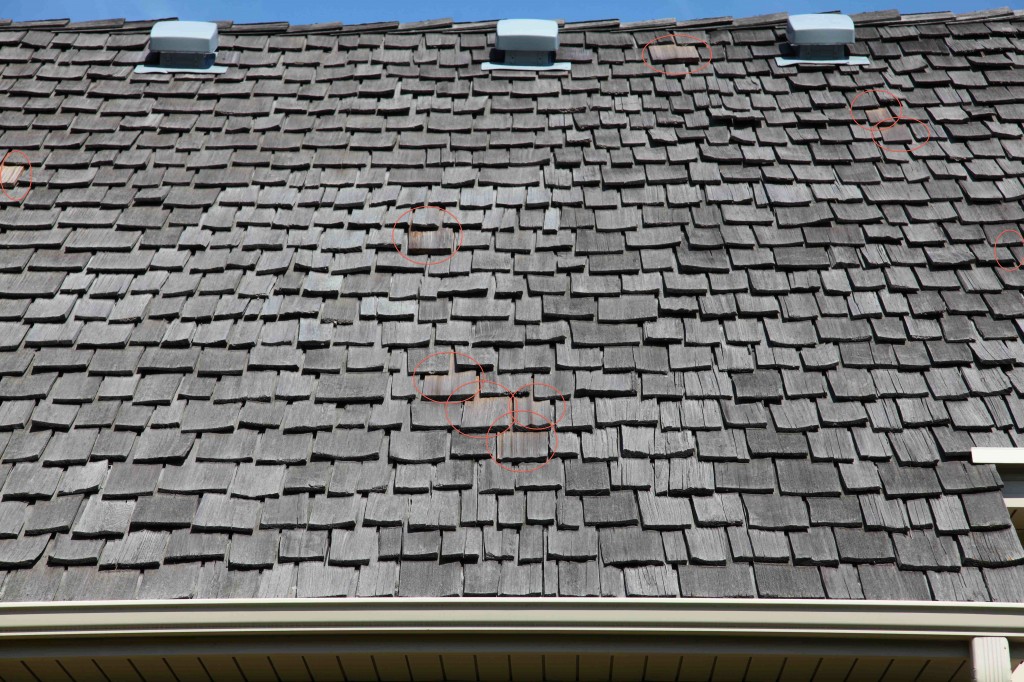
Here are the repairs on this cedar shake roof one year after installation on this Orono wood roof.
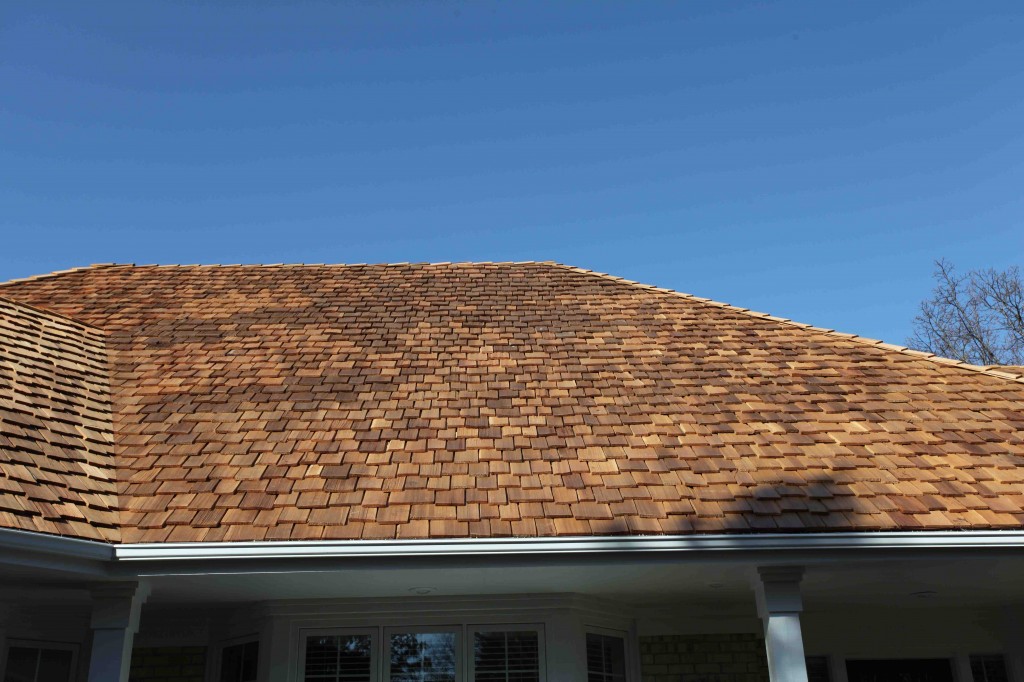
New wood shake roof in Minnetonka with color variations

14 year old heavy hand-split cedar shake roof with repairs two years after completion.
Posted in Uncategorized
Should wood roofs be pressure washed?
October 2nd, 2011
by Aaron Fruit
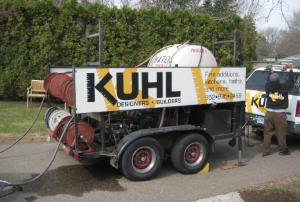 Having washed somewhere north of 2000 cedar shake and shingle roofs since the inception of our company in 1988, we have developed some strong opinions on the topic of whether or not it’s a good idea. Here is the definitive answer to whether or not wood roofs should be washed: Yes and no. You see the answer lies in the condition of your existing cedar roof. If it has integrity it is probably a good idea to wash, repair and preserve it. If it has aged too much, washing will only cause further damage. So how do you know where your roof lies on the spectrum? Call an honest company. We happen to be one of two such companies in the Minneapolis area. The other is Old Town Cedar, owned and operated by Dale Sloper. His phone number is (763) 441-8735. His wifes name is Sharon and they are solid people. We have lost more business to these guys than anyone else since we started our business in the late 80’s. So why on earth would we give our potential clients and existing clients their phone number? It’s simple. We care about the integrity of the cedar restoration business in the Twin Cities. The truth is when we lose a job to Dale we know the client will be getting a good job and we suspect he feels the same way about us. In the long run that is good for everyone including homeowners and roofing professionals. But I digress.
Having washed somewhere north of 2000 cedar shake and shingle roofs since the inception of our company in 1988, we have developed some strong opinions on the topic of whether or not it’s a good idea. Here is the definitive answer to whether or not wood roofs should be washed: Yes and no. You see the answer lies in the condition of your existing cedar roof. If it has integrity it is probably a good idea to wash, repair and preserve it. If it has aged too much, washing will only cause further damage. So how do you know where your roof lies on the spectrum? Call an honest company. We happen to be one of two such companies in the Minneapolis area. The other is Old Town Cedar, owned and operated by Dale Sloper. His phone number is (763) 441-8735. His wifes name is Sharon and they are solid people. We have lost more business to these guys than anyone else since we started our business in the late 80’s. So why on earth would we give our potential clients and existing clients their phone number? It’s simple. We care about the integrity of the cedar restoration business in the Twin Cities. The truth is when we lose a job to Dale we know the client will be getting a good job and we suspect he feels the same way about us. In the long run that is good for everyone including homeowners and roofing professionals. But I digress.
Back to the point of this post, which is pressure washing cedar roofs. To put it plainly, there are three or four other companies in the Twin Cities area that claim to be professional cedar roof restoration firms that are in fact what we call ‘morally flexible’ when it comes to determining whether or not cedar roofs should be washed. These guys have never met a cedar roof they wouldn’t wash. That’s not a good thing (except for their bank account). A couple times a year we will speak with Dale and compare horror stories about what we are witnessing these other companies doing around town. It’s shocking. They rely on the trust of homeowners to sign contracts for the ‘restoration’ of their roofs only to leave behind damage that will most likely not be detected for years when their roof needs to be replaced prematurely.
Are we are bitter because we lose business to these companies? Yes. Although the only reason we find homeowners chooses those guys is that they charge a lot less than we do. We have started a list of real homeowners in the Minneapolis area that have had regrettable contact with the aforementioned hacks and subsequently called us to fix the result or replace the roof altogether. Want to speak with them? Just ask Steve.
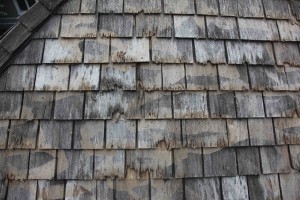 Here is a Kuhl Case Study on such a situation. A roof washing company used dinky, low-volume, high pressure machinery to wash this poor woman’s roof and the results weren’t pretty.
Here is a Kuhl Case Study on such a situation. A roof washing company used dinky, low-volume, high pressure machinery to wash this poor woman’s roof and the results weren’t pretty.
If your roof is in good enough condition to wash, congratulations. You have the opportunity to add years to its remaining life through occasional maintenance. But it is important to understand that a cedar roof should only be washed using specialized equipment. Standard pressure washers like the one pictured below will do a good deal of damage to a cedar roof regardless of the user. That damage will most likely not be visible from the ground because it is a matter of hundreds of an inch. In fact, consumer-grade pressure washers will remove between five and eight times the amount of wood from your cedar roof than professional equipment. If you have ever seen a cedar deck that looks furry and splintery after washing you know what we are talking about.
Companies that don’t invest in industrial equipment do so for one reason; it is much cheaper to use a standard machine than an industrial unit. From the ground the results look about the same to you. The discoloration on your roof is gone, the roof looks fresh and clean again. But upon close inspection you will see that those machines have removed a lot of wood. Not good. Regardless of the appearance from the ground, using a typical pressure washer on a cedar roof will take years off its existing lifespan regardless of whether or not wood cleaners and/or brighteners are used. Ultimately, wood loss in the keyways of your roof is one of the primary reasons your roof will fail in the future. Here is another Kuhl Case Study that explores the importance of using professional equipment when pressure washing a wood roof.
Here is a simple way to know if the guys you have hired are using the right equipment. If it shows up in the back of a van, it’s crappy. If it shows up on a trailer because it’s too big to fit in the back of a van, that’s a good sign.
Posted in Uncategorized
Birds Cause Ice Dams in Minneapolis
April 30th, 2011
by Aaron Fruit
Birds and Ice Dams
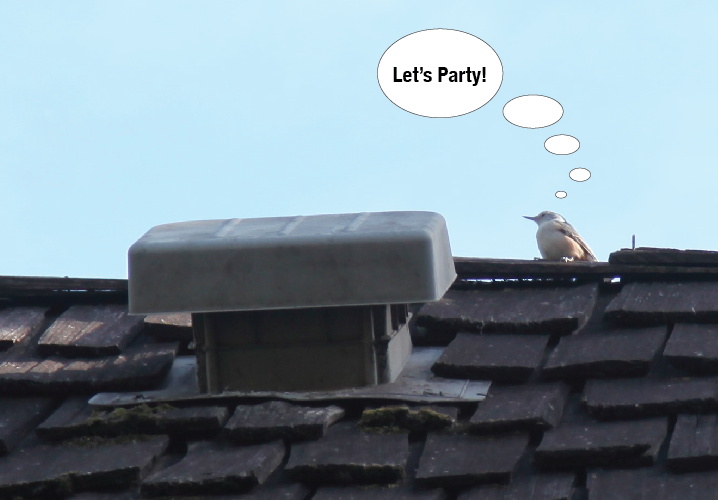
Kuhl replaces around 1500 of this type of roof vent every summer in the Minneapolis area because they are havens for critters
Birds might be the last thing you think about when you see ice dams forming on the edge of your roof this January. Yet birds can play a role in how they affect the ventilation of your roof. And as we all know, ventilation and insulation are two of the three key factors in ice dam prevention (air bypasses are the third). If you would like to geek out on ice dams here is the article I wrote for JLC two years ago.
Back to the birds. You see, birds have a strong attraction to a particular type of roof vent that pepper the roof tops of 75-85% of all homes in the Twin Cities. See Above. Proper air movement through your roof system is a very important point in the health of your home. Good air flow will also reduce the likelihood of ice dam and attic frost problems in the future. Most Minneapolis homes rely on two types of cooperative vents to carry fresh air through the rafter and truss spaces; the soffit vent and the roof vent. The main things that clog up soffit vents are sloppy painters who gum up the vent openings with paint, or, sloppy insulators who block the rafter openings that lead to the soffit vents with careless insulation work. Problems with roof vents, which exist near the peak of the roof, are almost always related to critters. Anything the inhibits the free movement of air through roof vents are a bad thing and are best avoided by using a quality vent. Find information on the average cost of roof vent replacement in Minneapolis later in this post.
Over the past 20 years we have replaced thousands of low quality roof vents with metal louvered vents. Many of those jobs had one thing in common; the homeowner had now idea there was a problem. Sometimes one can use a binoculars to inspect the roof vents from the ground successfully. You can see little bits of nesting materials hanging out of the vents. Case closed. It’s time to replace your roof vents. But frequently nests can’t be seen at all, leading the unsuspecting homeowner to think they are in the clear (below).
We did a roof repair in Shorewood last week where all but one of the 12 roof vents were filled with birds’ nests (Right). From the ground and from the roof everything looked good. After closer inspection we found the nests and were given the go-ahead to replace. I took a bunch of photos to show you what we find during these jobs.
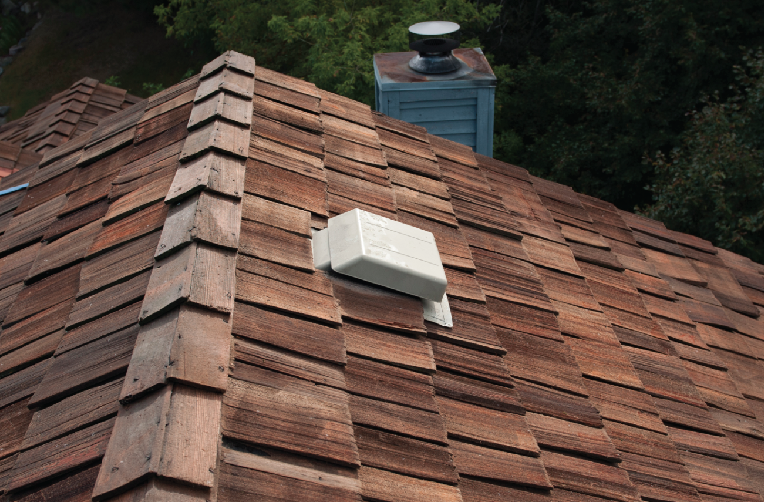
Sneaky birds nesting in cedar vents.
Cost for roof vent replacement in Minneapolis:
The sad part is the cheap vents (shown above) cost Minneapolis roofing contractors about $11.00 a piece while the really good vents cost about $14.00. The average Minneapolis home has about 10 roof vents, making the total cost difference between crappy and awesome about $30 during the installation of a new roof. Note that replacing existing vents is a far more expensive endeavor, with average costs ranging from $80 to $140 per vent for labor and materials. Therefore, installing good vents while your roof is being replaced is essentially free and doing it after the roof has been installed is likely a $1000+ affair.
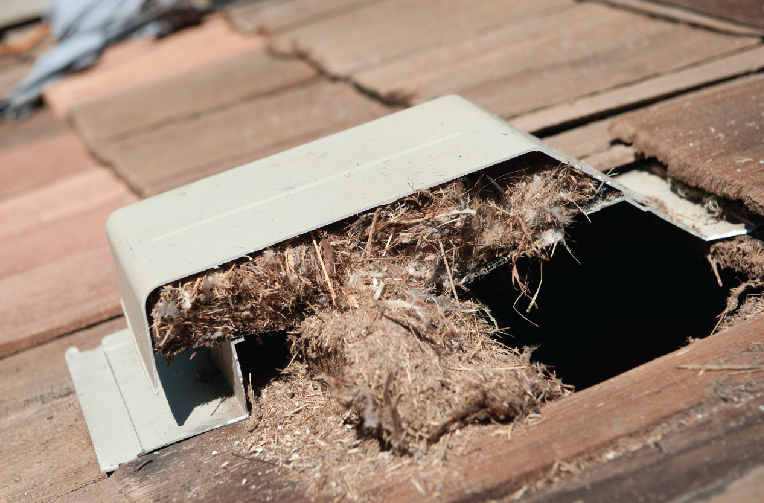
Same roof vent as above sawn in half. The nest has completely blocked the vent.
It’s not all bad news, however. If you are about to have a roof installed make sure to speak with your roofing contractor about what vents he is proposing. The upgrade should be provided at no extra costs if you are dealing with a reputable roofing professional.
Summary:
Although ice dams here in Minneapolis are the result of a complex interaction between the snow cover on the roof, the outdoor temperatures, and the heat-loss characteristics of the house, proper home ventilation is among the most important things you can do to minimize your risk. Relative to the cost of other home fixes such as reinsulating or heat cable installation, replacing bad roof vents is a pretty affordable job.
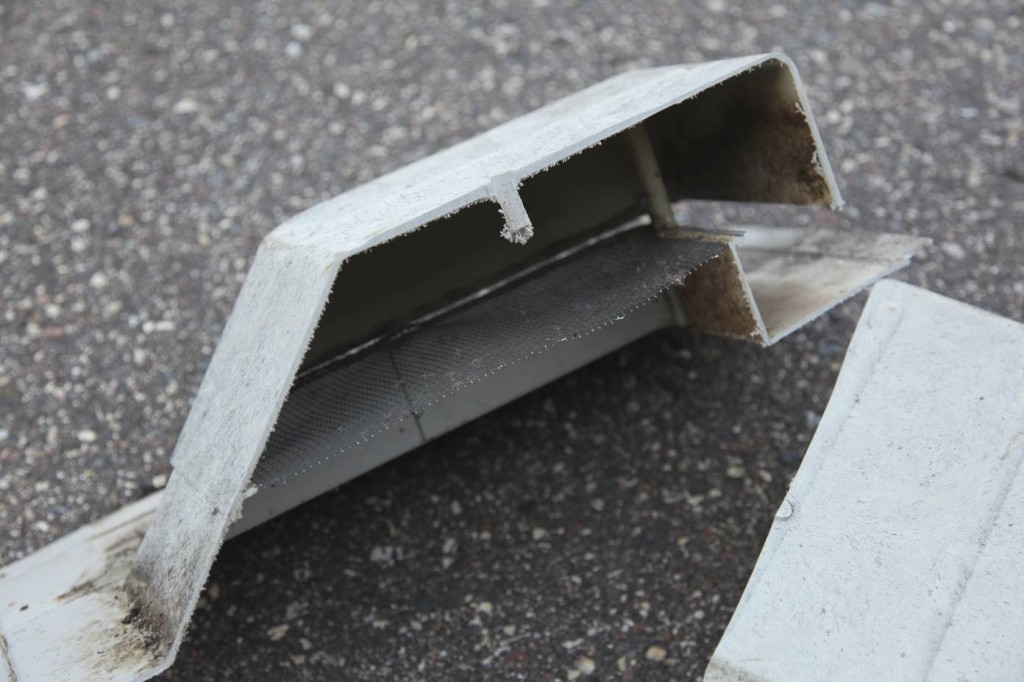
Ice dam prevent starts with good ventilation on Minneapolis Roofs
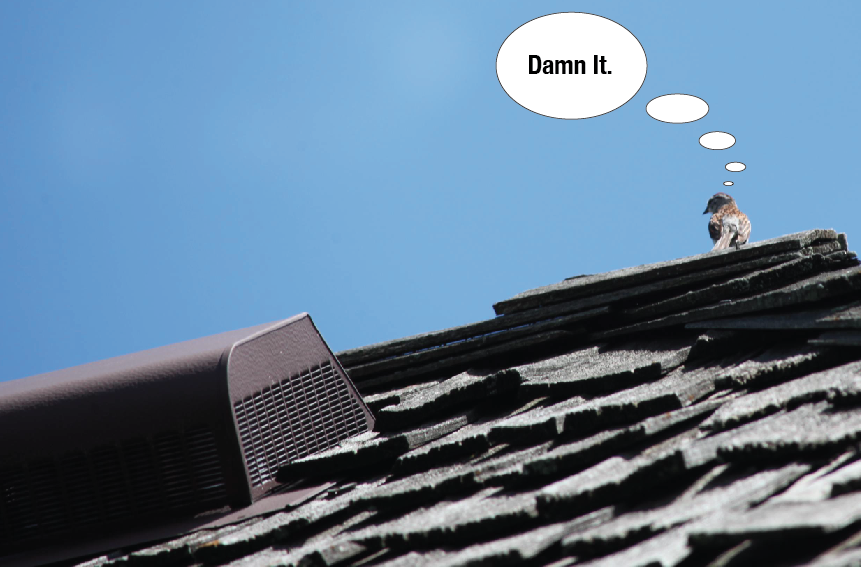
Bird saddened by impervious roof vent professionally installed by Kuhl.
Posted in Uncategorized
Ice Dam Scam: You Best Check Out His Equipment
February 2nd, 2011
by Aaron Fruit
As industry pioneers in ice dam removal and ice dam prevention, we have been asked many times about the best method to use for ice dam removal in Minneapolis. The answer is without question true steam. The ‘true’ in that answer is intentional because there are many ice dam removal companies in Minnesota who are claiming to use steam even though they are not. Buy our count the majority of the steaming companies are in fact using high-temp pressure washers. It’s not like the homeowner would know the difference anyway. Not until their roof is inspected the next summer when excessive granular loss (in the case of asphalt roofs) is discovered. More on that later.
Let’s get back to the difference between a steamer and a high-temp pressure washer. The easiest way to distinguish the two is to ask a simple question. What is the average operating temperature of the machine throughout the course of a typical job? You see, steamers emit steam at a minimum of 275 degrees from the time they are fired up to the second they are shut down. Our steamers normally run at around 315 degrees. High-temp pressure washers achieve temps of up to 300 degrees at start up but after a few moments of operation drop to just over 100 degrees. Why should you care? Because these machines need to rely on pressure to remove ice instead of temperature. Pressure damages roofs, steam does not. Here is a handy graphic that displays the fundamental differences between these two types of machine: Steamers vs. High-temp washers.
I can’t entirely blame homeowners for being duped by companies claiming to use steamers when in fact they are not. It’s hard to tell the difference unless you know what you are looking for. Both machines have a large kerosene fired burner assembly (either vertical or horizontal), both appear to produce steam out of the end of the gun when used, and both remove ice. The differences are really, really important if you talk to anyone who knows, however. In fact, a company called American Pressure sells the most ice dam steaming equipment and industrial pressure washers in the Midwest and is headed up by a father-son team named Gary and Ben Hagemann. Here is there website: www.americanpressureinc.com, and here is their phone number: (763) 521-4442. Call them and ask about the difference in performance between steamers and high-temp washers when it comes to removing ice dams. Ask them which type of machine is faster. Ask which is less likely to damage roofs? Ask what equipment they would like to be used on their own homes.
This begs the question, Why doesn’t every contractor just buy steamers in the first place? It comes down the oldest incentive in the book. Money. They buy the very cheapest machines that they can use for as many things as possible. Enter the high-temperature pressure washer. At one quarter the cost of a steamer, a high-temp pressure washer can be used all year long for washing cars, boats, decks, fences, roofs, sidewalks and more. Sure they slower at removing ice dams than a steamer and far more likely to cause damage to asphalt shingles, but their sheer versatility is too much for the average contractor to resist. Our steamers run around $4,000 before we customize them for our work and they can only be used for one thing; steaming the shit out of ice dams. (I was told I could swear because it’s a blog…sorry).
We guarantee that the machinery we are using are in fact true steamers. Period. I suggest that anyone hiring a company to remove ice dams in Minneapolis using steam check very carefully into the accuracy of that company’s claims. Look closely at the machine that shows up in your driveway. Write down the make and model, run inside and call Gary or Ben to get their opinion. If you care about spending as little possible to safely remove the ice dams from your business or home and you hope to not find damage when the snow melts off the roof in the spring, you will kick those guys off your property before they get started.
Here’s the popular article Steve Kuhl wrote for JLC in 2011: Ice Dams 101. If you care to geek out on the topic of ice dam removal and ice dam prevention you should really check it out. None of our competitors can claim to be nationally published in this way. Not to brag.
Posted in Uncategorized
Kuhl’s Contracting’s Contribution to a Blend Award-Winning Home
September 15th, 2010
by Aaron Fruit
Blendaward.org is an organization that encourages and rewards builders, architects, and home owners to blend newly remodeled or constructed homes and businesses into the fabric of Minneapolis neighborhoods.
We are proud to announce that we have been selected as a winner for the 2010 Blend Awards.
Posted in Uncategorized





















